During summer, small brown bugs usually trouble homeowners with their presence. Most of these pests are known to carry diseases and cause some damage.
Here are the common 9 small brown bugs in your house:
- Drugstore Beetles
- Carpet Beetles
- Silverfish
- Weevils
- Cockroaches
- Ticks
- Fruit Flies
- Drain Flies
- Stinkbugs
In this article, we will cover how to identify these insects, the reason why they end up in your home, and some ways to get rid of them.
Small Brown Bugs in Your House | Identification, and Habitat
There are many types of bug species that commonly invade homes, and some of them are ticks, drugstore beetles, fruit flies, and more. Since these pests are known to cause damage and pose health risks, identifying them is a must so you can apply appropriate steps to get rid of them.
Through accurate identification, you can get rid of these insects below effectively and prevent them from coming back:
Drugstore Beetles
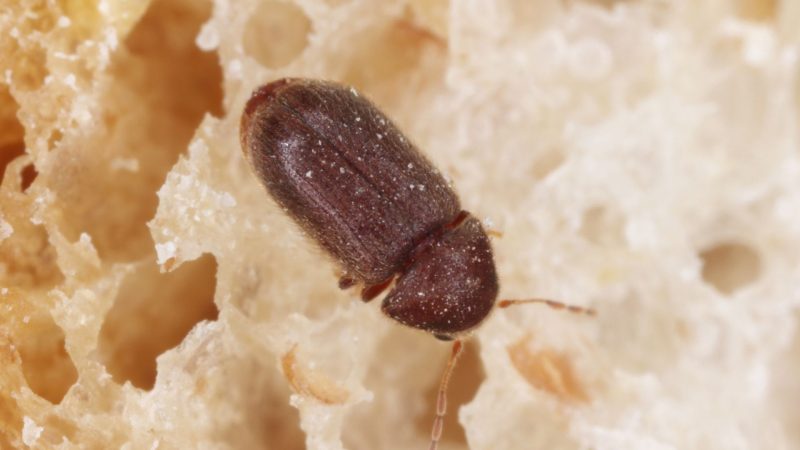
Drugstore beetles are wood borer bugs that usually live within stored foods, such as cereals, cookies, bread, and other food items that aren’t stored in secured containers. They’re particularly seen in pantries and kitchens, where spills and crumbs are common.
They’re commonly known as cigarette beetles, resembling anobiid powderpost beetle. In addition, they’re 1/16 – 1/8 inch long, possess a light-brown color, and are oval in shape.
Moreover, they have a hood-like shield known as prothorax, enclosing and concealing their heads when seen from above.
Carpet Beetles
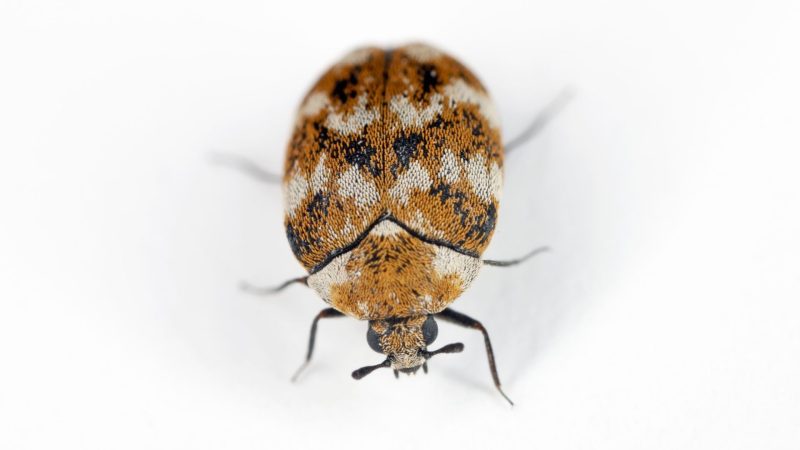
Carpet beetles are typically seen in carpets and around your rug’s edges. They can grow on lint and debris gathering beneath the baseboards and within the ducts and vents.
You can identify the adult carpet beetle with their shiny, black to dark brown bodies and brownish legs. Their lengths range from 1/8 of an inch to 3/16 of an inch.
Meanwhile, larvae can grow up to 5/16 of an inch and possess light brown to black color. They also have smooth, shiny bodies that are hard and short, stiff hairs covering them.
Silverfish
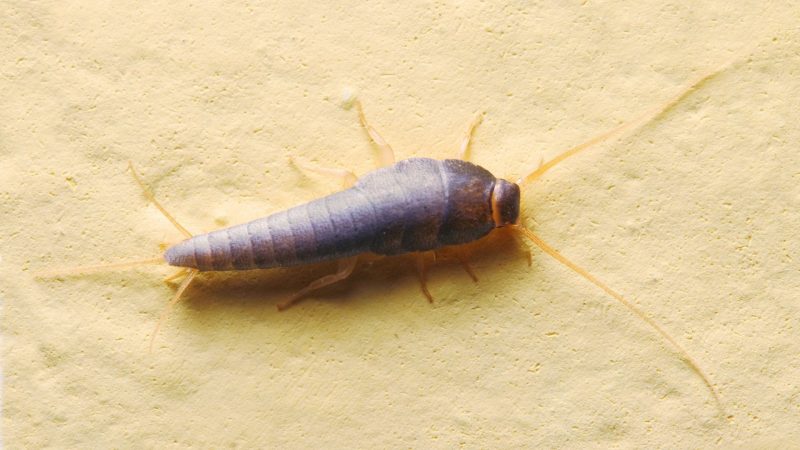
Silverfish live in moist spaces with high humidity and darkness. Additionally, they also prefer places where there are plenty of starches-based materials, like books and boxes. This is why they’re often detected in:
- Attics
- Garages
- Basements
- Bathrooms
- Living rooms
- Bedrooms
As the name suggests, silverfish typically appear silver in color due to the shimmery quality of their skin. However, their real color is light grey and blue.
They possess carrot-shaped bodies with three obvious tails on the rear. On top of that, they also have two slender antennas and are wingless.
Weevils
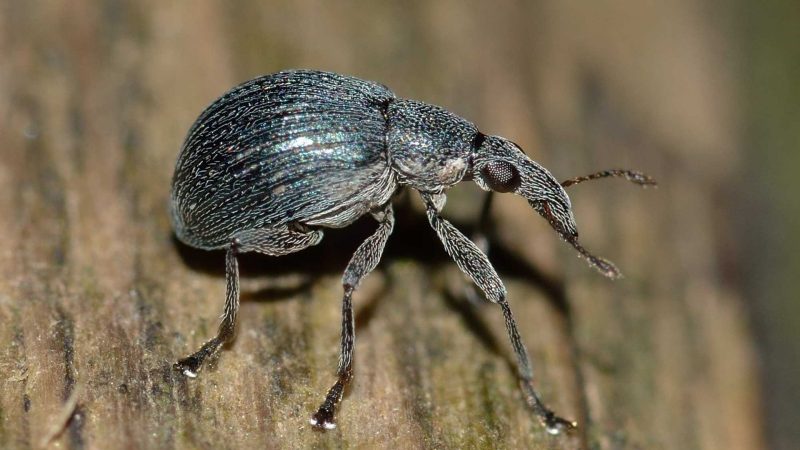
Typically, weevils feed on plants. But, once they gain access to your home through cracks and holes, they’ll start infesting by contaminating stored foods with their excretion.
They’re often found gathering by the windows. Although some weevil species, like rice weevils, can be seen in kitchen areas due to the foods they can get there, such as cereals, beans, and nuts.
You can distinguish weevils from other small brown bugs with their unusually long, down-curving muzzle. They also possess small, elbowed antennae and are 1/4 of an inch in length.
Cockroaches
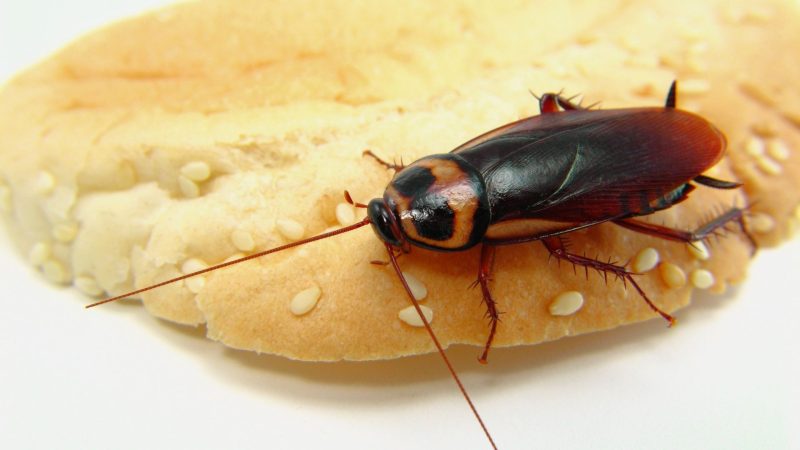
Cockroaches are pests known to carry various diseases through their excretion. They’re mostly seen in crevices and narrow cracks of your home, where they’re undetected.
You can also find these pests under the sinks, drawers, cabinets, and behind refrigerators due to the moisture in these areas. These pests are nocturnal, so they seek food at night. They prefer sweet, starchy foods, meats, and any crumbs that they can get in your kitchen.
Identifying them is easy with their flattened oval body, bent downward head, and long antennae. Their length can range from 1.4 to 2 inches. Furthermore, they have shimmering brown or black leathery integuments.
Ticks
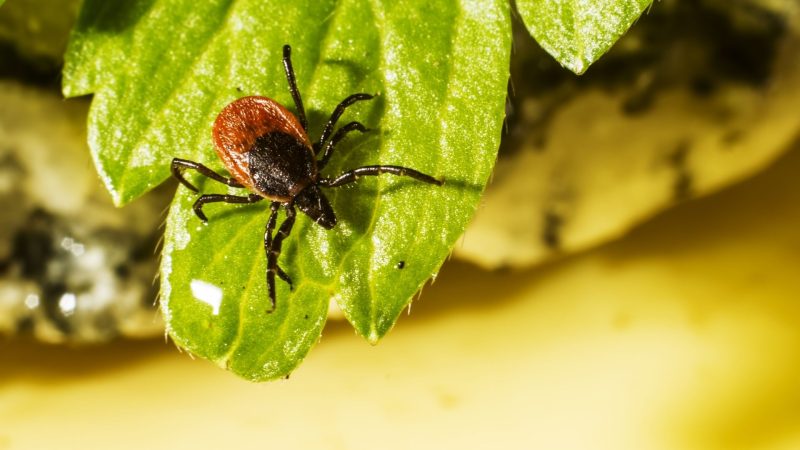
Ticks are parasitic pests that lay eggs in several parts of your home, such as the window, baseboards, curtains, and furniture. They have an oval body shape, consisting of the abdomen and cephalothorax.
In addition, they have a ‘false head’ that protrudes forward past their bodies and four pair of legs. Ticks don’t have an antenna and are approximately 3/16 of an inch.
Unfed females and male ticks are reddish-brown. You can distinguish the female from the male by spotting the big, silver-colored area behind their head.
Furthermore, female ticks grow as big as 1/2 of an inch after feeding, comparable to the size of a grape.
Fruit Flies
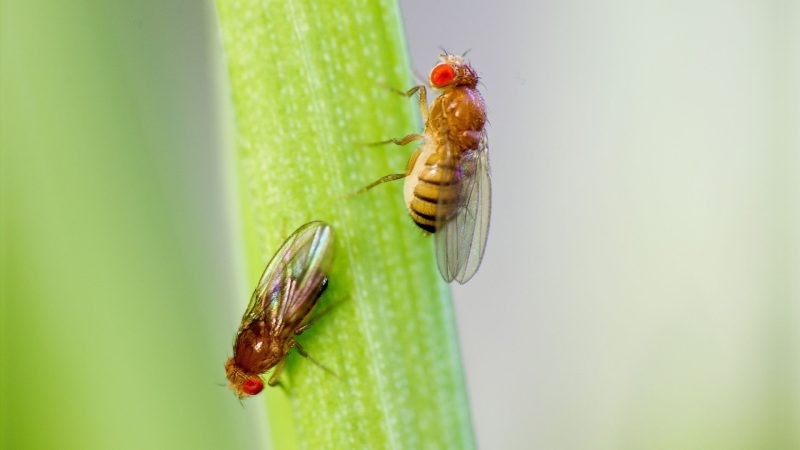
Fruit flies are known to breed in trash containers, drains, and empty bottles of sodas. They’re especially drawn to rotting vegetables and ripened fruits in the kitchen.
You can identify them with their feathery bristle antenna, thickened from margin wings, and typically bright red eyes. Their bodies are tan except for their rear part, which is black and can grow up to 1/8 of an inch.
Drain Flies
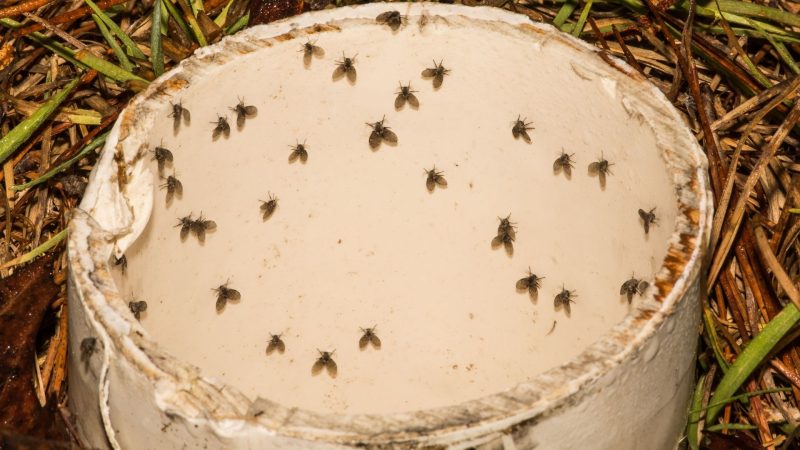
Drain flies typically live in areas where water accumulates, such as rarely used toilet bowls, sinks, floor drains, and drain pans found under the refrigerators.
One can identify drain flies with their tan or light gray bodies and light-colored wings. On top of that, their wings and bodies are covered with long hairs, giving them a hairy, moth-like appearance. These insects can grow up to 1/8 of an inch.
Stinkbugs
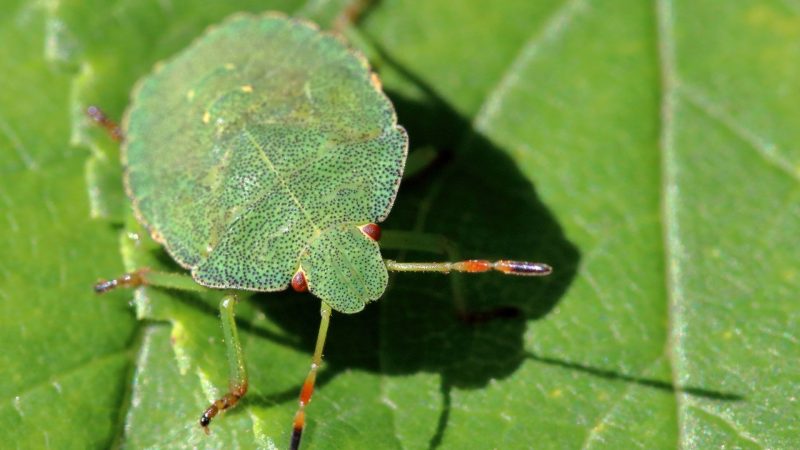
Stinkbugs are pests that prefer to dwell within your walls, crawl space, or attic during winter. They possess solid green color with a yellow-orange rim around their scutellum.
The stinkbugs have black antennae, and their sizes range from 0.5 of an inch to 0.7 of an inch. These insects feed on a variety of food, such as tomatoes, peaches, soybeans, and more.
These insects invade homes in search of a warm place to stay during the winter season.
Why Do You Have These Tiny Brown Bugs in Your House?
If you find any tiny brown bugs species in your house, such as drain flies, stinkbugs, and fruit flies, it means something attracts them. For example, if you see fruit flies flying around — there could be ripened fruits in your kitchen or rotting meat and vegetables in your trash bins.
Moreover, if you see drain flies flying around your property, there could be stagnant water or leaking pipes in your house.
How to Eliminate Small Brown Bugs in Your House Naturally?
Eliminating small brown bugs can be a tedious job, especially if you don’t know the species of bugs you’re encountering. So, if you’re not up to this task, you may call a local pest control service provider to handle the job for you.
On the other hand, you can use natural remedies, such as:
Neem Oil
Neem oil comes from the neem tree and is known to effectively kill over 200 insect species. All you have to do is spray the oil in areas where you often see these little brown bugs.
This oil is safe for humans and pets, so you can apply them frequently as you like. You can buy this oil in your local supermarket or on trusted platforms online.
- Kills Eggs, Larvae and Adult Stages of Insects
- Prevents & Kills Black Spot, Powdery Mildew and Rust
- Pest Control: Spider Mites, Aphids, Whiteflies and Other Insect...
- Use on all Roses, Flowers, Houseplants, Fruits, Nuts, Ornamental...
- Use on Vegetables Grown In and Around the Home and Garden
Peppermint Oil
Peppermint oil has a pleasant smell and is known for its efficient role in repelling stinkbugs, drain flies, and many other insects. To make the solution, just mix 8 oz of water and 10 to 15 drops of peppermint oil in a clean spray bottle.
Once done, shake the solution lightly and spray it in your vents, doorways and windows.
- 100% PURE & NATURAL PEPPERMINT OIL - Majestic Pure Blends oils...
- PREMIUM GRADE & QUALITY – All Majestic Pure Blends Essential...
- HIGH QUALITY GLASS BOTTLE – Our Essential Oil comes in an amber...
- PEPPERMINT OIL BLENDS WELL WITH – Basil, Coriander, Eucalyptus,...
- BOTTLED – Our oils are sourced from the best regions all over...
Diatomaceous Earth (DE)
has been known as an effective insect killer. This is produced from fossilized, crushed single-cell algae that can absorb the moisture of various insects, such as stinkbugs, bed bugs, beetles, and more.
To use this, just sprinkle DE to the ground or directly to the bugs you encounter. After 48 hours of contact with diatomaceous earth (DE), the bugs will die due to dehydration.
No products found.
Pyrethrin
Pyrethrin is an insecticide produced from the chrysanthemum flower. This works by targeting the nervous system of insects, killing them quickly.
All you need to do is spray the solution to the areas where these brown bugs are frequently hanging.
- Pyrethrin Garden Insect Spray Concentrate from Bonide is a fast...
- Designed for use on asparagus, beans, broccoli, peppers, spinach,...
- The active ingredient, pyrethrin, naturally occurs in...
- Garden Insect Spray Concentrate can be used on vegetables up to...
- This product quickly mixes with water and should be applied using...
Ways to Prevent These Bugs From Returning
Getting rid of the small brown bugs within your home isn’t the end of your battle. There’s always a possibility that they can return anytime. To avoid that from occurring, you can use the given tips below to make your home bug-free.
Clean Your Place Regularly
Nothing attracts bugs more than an unkempt home. So, make sure to clean your areas well and get rid of elements that attract these pests to your place.
For example, if you have stagnant water, make sure to eliminate that and keep your areas dry. In addition, make sure to seal any cracks and holes to prevent these bugs from residing in your place.
Maintain Your Yard
The tiny brown bugs begin as outdoor insects first before settling into your house. Thus, it would help if you keep your grass well-maintained to prevent the entry of these pests from your property.
You can start by trimming overly thick bushes and mowing the grass. Ensure to pay attention to areas with many vegetations as these sites are ideal for roaches and ticks.
Seal Entry Points
As stated previously, the brown bugs came from outdoors and have gained access to your home through holes and cracks. To prevent these pests from coming in and out of your property, sealing the entry points is a big help.
To do this, start by examining the areas of your home thoroughly for any holes or cracks and seal them up. You can close the voids by using stucco or caulk to ensure your home is impenetrable to pests.
Summary
Small brown bugs aren’t much of a concern if you deal with them right away. If you’re currently encountering any bug problems, taking quick action can make a huge difference.
You can use the remedies listed in this article or call a professional pest control company to deal with your bug problems.
Related: Small Black Bugs in House | Identification and Control Guide
List of Sources
Carpet Beetles. University of Kentucky.
Hahn, J., Ascerno, M. (2019). Cockroaches. University of Minnesota.
Why Do I Have Cockroaches in My Home? (2016). National Pesticide Information Center.
- How to Get Rid of Turtles | Proven Long-Term Solutions! - August 26, 2023
- How to Get Rid of Kingsnakes | Easy & Humane! - August 26, 2023
- How to Get Rid of Northern Water Snakes | Best Solutions and Preventative Measures! - August 19, 2023




